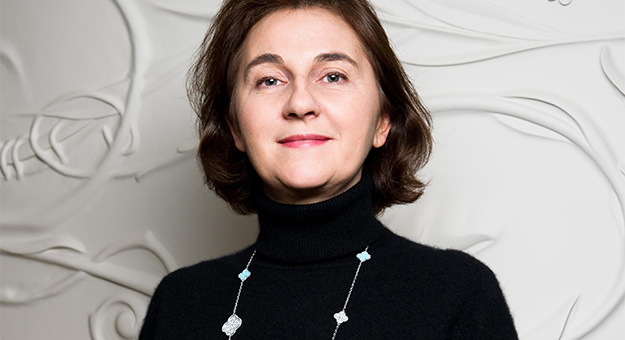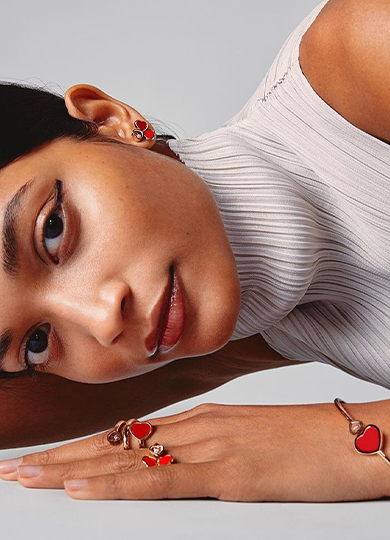Before every jewel is crafted, before a gem is set or a clasp is fastened, there is a drawing. Often delicate, sometimes painstakingly precise, these renderings capture the very first spark of creation: a moment where imagination meets craftsmanship on paper. Yet, for all their beauty and importance, jewellery drawings have long remained in the shadows of the finished pieces they inspired.
That quiet artistry took centre stage in Designing Jewels: 200 Years of French Savoir-Faire (1770–1970), an exhibition co-presented by the University Museum and Art Gallery of The University of Hong Kong (UMAG) and L’ÉCOLE, School of Jewelry Arts, Asia Pacific. Featuring over a hundred rarely seen design drawings and select masterpieces from the archives of renowned French Maisons, the exhibition illuminated how every exquisite jewel begins with a single line—and how those lines tell the story of centuries of innovation, artistry, and human touch.


For L’ÉCOLE, founded with the support of Van Cleef & Arpels, this project reflects a broader mission: not only to preserve the heritage of jewellery-making, but to educate and inspire. Through exhibitions, research, and hands-on learning, the school continues to champion the artistry behind adornment, reminding us that patience, curiosity, and craftsmanship remain timeless virtues in an age of speed.
In conversation with BURO, Mathilde Berger-Rondouin, art historian and lecturer at L’ÉCOLE Asia Pacific, School of Jewelry Arts; and Florian Knothe, art historian, curator and Director of the University Museum and Art Gallery , revisit the ideas that shaped the exhibition and the lessons it leaves behind. Drawing on their extensive research and curatorial insight, the two articulate why jewellery drawings are far more than preparatory steps—they are cultural artefacts that preserve the thought processes, technical ambitions and artistic sensibilities of their time, thus underscoring L’ÉCOLE’s commitment to safeguarding this heritage while inspiring new ones to come.
WHAT WAS THE GUIDING NARRATIVE BEHIND THIS EXHIBITION, AND WHAT DO YOU HOPE VISITORS TOOK AWAY FROM IT?
M: The exhibition focuses on French-made jewellery and workshops, primarily because France—especially Paris—has historically been the centre of jewellery craftsmanship. Much like haute couture, much of the terminology and stylistic vocabulary used in fine jewellery originates in France. For visitors in Asia, where this history is less familiar, starting with French examples provides a coherent and accessible foundation.
We wanted to highlight 200 years of craftsmanship that are often overlooked: the behind-the-scenes work of designers and artisans whose drawings were the first step in creating every jewel. Every handmade luxury object—whether furniture, garments, or jewellery—begins with a blueprint. That idea, of drawing as the foundation of creation, is central to the exhibition.
F: As French decorative-arts historians, it was natural for us to begin there.
M: Yes, and because we’re based in Hong Kong, we also wanted to build bridges with Asia. But curating an exhibition requires coherence. The Jewelry Culture Fonds in Paris holds a vast number of drawings, many of which were produced by French workshops. Those archives are easily accessible to researchers there—through guilds, trade offices, and national archives—so it made sense to focus the exhibition on that material.


Previous curators in Paris published a wonderful book that concentrated mainly on 19th-century drawings. We decided to extend the narrative to 1970 to make the exhibition more relevant for younger audiences. Ending around 1910 might have given the impression that hand-drawing stopped being important, but in fact, the craft continued to evolve well into the 20th century.
F: The second floor of the exhibition, which explores the post-war period, is entirely new. We re-curated and expanded the historical narrative to include more contemporary examples.
M: We also wanted visitors—especially students—to see that traditional methods are still in use. Even with photography and digital tools, many designers continue to render their designs by hand. We collaborated with contemporary jewellery artists to present live demonstrations of gouache rendering, showing the continuity of skill from the 18th century to today.
Interestingly, in 2017, the Haute École de Joaillerie in France introduced a dedicated programme for jewellery design and illustration, underscoring the renewed recognition of gouache artists as professionals in their own right. It’s a reappraisal of craftsmanship that fosters both preservation and innovation.



THE 19TH CENTURY IS CENTRAL TO THIS EXHIBITION. WHAT MADE IT SUCH A TRANSFORMATIVE PERIOD FOR JEWELLERY DESIGN?
M: The 19th century marked a turning point because of the Industrial Revolution. Paper became more affordable and widely available, and literacy rates improved. That made drawings and printed catalogues more accessible, which in turn encouraged the production and collection of design drawings.
As industry expanded, so did the diversity of jewellery. There were pieces for mourning, for weddings, for debutantes, and for church ceremonies—categories that previously only royalty could afford. The more objects were made, the greater the need for precise, hand-drawn blueprints.
Another key factor was the rise of World Fairs. To participate in exhibitions like those in Paris, Vienna, or London, jewellers had to submit portfolios showcasing their designs and technical expertise. These drawings became both marketing tools and official records of craftsmanship.
F: The World Fairs also encouraged innovation. Winning an award brought prestige and visibility, and publications reproduced many of these designs, further spreading the influence of French craftsmanship worldwide.



HOW DO THESE HISTORICAL DRAWINGS HELP US UNDERSTAND THE INNOVATION BEHIND JEWELLERY MAKING?
M: The evolution of colour in drawings—particularly the use of gouache—reveals how gem-cutting and material sourcing advanced over time. Through the palette, you can trace when new mines were discovered or when certain stones became fashionable. For example, the discovery of diamond mines in Africa in the 19th century led to an emphasis on white gems, which in turn influenced the shift to blue-grey drawing paper to better contrast their brilliance.
F: These drawings also record the evolution of stone quality, setting techniques, and craftsmanship. We often take the “perfect” cut for granted today, but older pieces demonstrate different aesthetics and methods. The drawings remind us that jewellery artistry existed long before modern standards—and that those early pieces are equally beautiful.
M: Exactly. Even 150 years ago, jewellers were mastering complex rendering techniques to capture the play of light on stones. Each drawing offers technical clues about the materials, cuts, and methods used at the time.



THE ZIP NECKLACE BY VAN CLEEF & ARPELS WAS CONCEIVED IN THE 1930s AND REALISED IN THE 1950s. HOW DOES ITS STORY REFLECT THE CHALLENGES AND POSSIBILITIES OF THAT ERA?
M: The Zip Necklace is fascinating because it embodies both innovation and circumstance. The concept emerged in the late 1930s, but the Second World War delayed its realisation. During the war, Paris was occupied, workshops closed, craftsmen went to fight, and gold became restricted to military use. It wasn’t until the 1950s that Van Cleef & Arpels could finally produce it.
Even without the war, such a design would have taken years to perfect. The mechanism—transforming from a necklace into a bracelet—was highly technical. Gold’s unique malleability made it the ideal material, but getting the sliding device to work was an engineering challenge.
F: It’s truly an engineering marvel.
M: Absolutely. It recalls the ingenuity of automata or elaborate clocks from earlier centuries—objects created purely to inspire wonder. The Zip Necklace was developed through countless trials; the archives contain notes detailing failed attempts and material experiments. It represents the dialogue between creativity and craftsmanship that defines haute joaillerie.



HOW DOES THAT SPIRIT OF INNOVATION CONTINUE TO INFLUENCE JEWELLERY DESIGN TODAY?
M: That creative dialogue between designer and craftsman still exists. Designers may imagine something bold, while the workshop worries about feasibility or wearability—and sometimes it’s the reverse. It’s a constant negotiation between artistry and practicality.
These drawings capture the first stage of that dialogue. You can almost sense the back-and-forth—the technical notes, the debates over materials, the adjustments to proportions. It’s a collaborative process, as true today as it was two centuries ago.
F: Many museums, such as the Victoria and Albert Museum in London, began collecting these drawings precisely for that reason—to teach. They serve as reference points for future generations, illustrating what to do, what not to do, and how to evolve craftsmanship while learning from the past.


M: Ultimately, the drawings show that, regardless of the passage of time, human creativity always finds a way to realise beauty. Whether it takes years or decades, these “wonder pieces” eventually come to life. They’re testaments to patience, mastery, and dedication—values that remain timeless.
Over 200 years, tools and technologies may have changed, but the essence of the jewellery drawing has remained constant. Each is drawn to scale, one-to-one with the finished piece. Early drawings were monochromatic; later ones used colour and shading to convey three-dimensionality. By the 20th century, details like necklines or earlobes began appearing to indicate wearability, as functionality became central to design. It’s an evolution that mirrors the growing complexity of jewellery itself.

JEWELLERY IS TIED SO DEEPLY TO MEMORY AND EMOTION. WHAT IS THE MOST MEANINGFUL PIECE OF JEWELLERY YOU OWN?
F: Men generally have fewer pieces, but for me, it’s my family signet ring. It bears our crest and has been passed down through generations. You can’t buy something like that—it’s unique to one’s lineage.
M: That’s a beautiful example, because signet rings were originally created for men and functioned almost like personal identity cards. They symbolised heritage and belonging. For women, the equivalent is often the engagement or wedding ring—objects tied to significant life events.
In my case, I never remove my wedding band. My husband feels the same; he believes taking it off would bring bad luck. Jewellery can be a marker of love, achievement, or continuity—connecting us to our ancestors and to moments that define who we are. No matter where you go in the world, everyone has at least one piece that tells their story.



| SHARE THE STORY | |
| Explore More |





